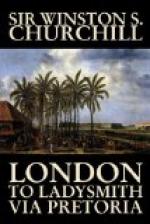It seems that a misunderstanding, of the rights and wrongs of which the reader shall be himself a judge, arose with the enemy. When day broke, the Boers, who were much nearer to the wounded than were our troops, came out of their trenches with a Red Cross flag, and the firing thereupon ceased locally. Our people ought then to have been ready to come forward with another Red Cross flag, and an informal truce might easily have been arranged for an hour or two. Unfortunately, however, there was some delay on our part. The Boers therefore picked up their own wounded, of whom there were a few, gave some of our men a little water, and took away their rifles. All this was quite correct; but the Boers then proceeded to strip and despoil the dead and wounded, taking off their boots and turning out their pockets, and this so infuriated the watching soldiers behind the wall that they forthwith fired on the Boers, Red Cross flag notwithstanding. This, of course, was the signal for fighting to recommence fiercely, and during the day neither side would hear of parley. The Boers behaved cruelly in various instances, and several wounded men who tried to crawl away were deliberately destroyed by being shot at close quarters with many bullets.
During the 24th there was heavy firing on both sides, but no movement of infantry on either. The army suffered some loss from the Boer artillery, particularly the automatic guns, which were well served, and which enfiladed many of our positions on the slopes of the low kopjes. In this way Colonel Thorold, of the Royal Welsh Fusiliers, and other officers, met their deaths. The casualties were principally in Hildyard’s English and Kitchener’s Lancashire Brigades. Hart’s six battalions found good cover in the gorge of the Tugela.
Sir Redvers Buller now saw that his plan of filing his army round the angle of the river and across the enemy’s front would, in any case, be very costly, and was perhaps impossible. He, therefore, determined to get back to the Hlangwani plateau, and try the extreme left of the enemy’s position. He had the strategic advantage of being on interior lines, and was consequently able to move his troops with great ease from one flank to the other. His new plan was to pass the brigades of his left and centre across the pontoon bridge from the left to the right, so that Hart, who was formerly the extreme right, would now become almost the extreme left, and, having thus extended his right arm, to cross the river where it flowed east and west, and make a still wider swoop on the enemy’s flank.
The first thing to do was to move the heavy guns, and this, with certain redistributions of the cavalry, occupied the whole day. A long-range four-gun naval battery was established on the western slopes of the Monte Cristo ridge. Another similar battery was placed on the spurs of Hlangwani. The 4.7-inch naval guns and the 5 in. fortress battery were brought into line in the centre of the Hlangwani plateau. All this was good. The big guns were getting back on to the big hills. The firing, which continued all day, swelled into a roar towards night as the Boers made vigorous attempts to drive Hart’s Brigade from its lodgments. They were, however, foiled in their endeavour to squeeze in between the troops and the river.




